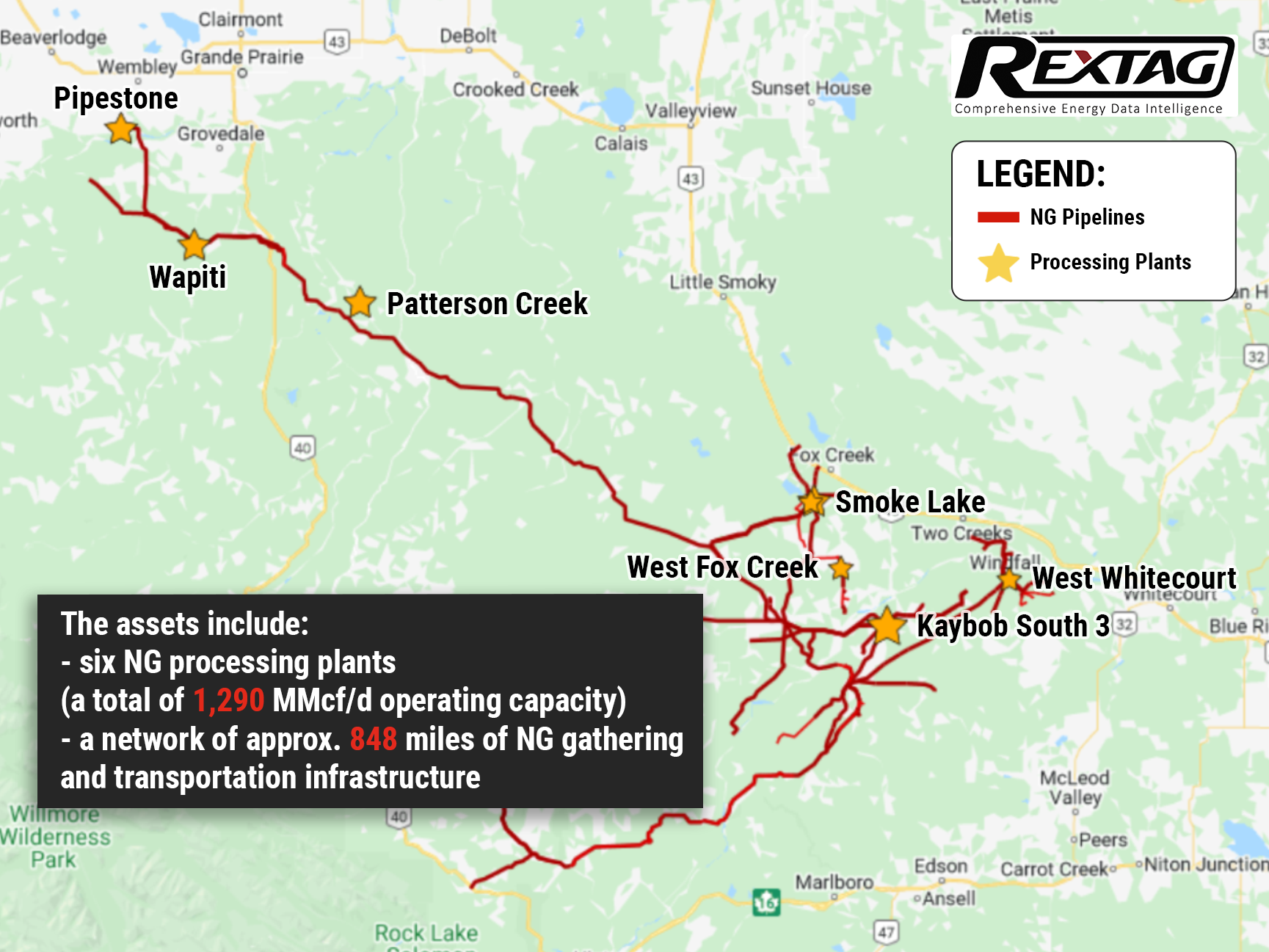Comprehensive Energy Data Intelligence
Information About Energy Companies, Their Assets, Market Deals, Industry Documents and More...
Canadian Assets on Sale: Energy Transfer Sells Gas Processing Bussines to Pembina-KKR for $1.3 Billion
04/19/2022
Under the agreement, Energy Transfer will sell its 51% interest in Energy Transfer Canada to the Pembina-KKR joint venture, for more than CA$1.6 billion (US$1.3 billion) including debt and preferred equity. KKR's funds already own the remaining stake.
TC’s assets include six natural gas processing plants with a combined operating capacity of 1.29 Bcf/d and an 848-mile natural gas gathering and transportation network in the Western Canadian Sedimentary Basin.
Through this agreement, Energy Transfer will be able to divest its high-quality Canadian assets at an attractive valuation, deleveraging its balance sheet and allowing it to redeploy capital within the U.S. market.
The Calgary-based company, Energy Transfer Canada, is one of Alberta's largest gas processors. As part of its portfolio of assets, the company owns six gas processing plants with a combined capacity of 1,290 MMcf/d, as well as a network of approximately 848 miles of natural gas gathering and transportation infrastructure.
As a result of the sale, Energy Transfer is slated to receive cash proceeds of approximately 340 million Canadian dollars (US$270 million), and close by the third quarter of 2022.
While this process is underway, Pembina and KKR will combine their western Canadian natural gas processing assets into a single, new joint venture entity — Newco, owned 60% by Pembina and 40% by KKR. Pembina will also be Newco's operator and manager.
This new entity will acquire Pembina's field-based natural gas processing, Veresen Midstream's portfolio (55% owned by KKR funds, 45% by Pembina), and ETC's business. And is expected to have a natural gas processing capacity of about 5 Bcf/d or about 16% of Western Canada’s total processing capacity. The worth of this joint venture will be around CA$11.4 billion (US$8.99 billion).
It is expected that all the deals will close late in the second or third quarter. According to Pembina, it plans to sell its interest in its Key Access Pipeline System as a way to finance the deal, and it is reviewing its portfolio for other noncore, nonoperating assets that might be sold in the process.
After the deal closes, Pembina plans to raise its dividend by 3.6%, as well as raise its share repurchase target to CA$350 million (US$275 million) from CA$200 million.
If you are looking for more information about energy companies, their assets, and energy deals, please, contact our sales office mapping@hartenergy.com, Tel. 619-349-4970 or SCHEDULE A DEMO to learn how Rextag can help you leverage energy data for your business.
Decades of free inventory from one deal: Vermilion Energy buys Leucrotta Exploration for $477 million
![$data['article']['post_image_alt']](https://images2.rextag.com/public/blog/57blog_Vermilion_Acquires_Leucrotta's_Montney_Assets_2022.png)
As part of its effort to expand its Montney Shale play, Vermilion Energy Inc. recently acquired Leucrotta Exploration Inc. for a net cash purchase price of CA$477 million. Vermilion has identified 275 high-quality, high-return, low-risk multi-zone drilling prospects. Top management believes, these prospects represent 20 or more years of low-risk, self-funding, high-deliverability shale drilling. Assuming the anticipated May closing date, Vermilion is increasing its capital budget for E&D in 2022 to $500 million and increasing guidance for production from 86,000 to 88,000 boe/d to take into account the Leucrotta acquisition.
$690 Million Deal Moves Ahead: Crescent Energy to Complete Purchase of EP Energy's Uinta Assets
![$data['article']['post_image_alt']](https://images2.rextag.com/public/blog/56Blog_Crescent_Bought_EP_Energy's_Uinta_Assets.png)
Crescent Energy closed the acquisition of Uinta Basin assets in Utah that were previously owned by EP Energy for $690 million, a few hundred million dollars below the original price. The accretive deal increases Crescent's Rockies position and adds significant cash flow and a portfolio of high-quality oil-weighted undeveloped sites. In addition to its acquired Uinta assets, Crescent's pro forma year-end 2021 provided reserves totaled 598 million boe, of which 83% was developed, 55% was liquid, and its provided PV-10 was $6.2 billion.
![$data['article']['post_image_alt']](https://images2.rextag.com/public/blog/326_Blog_USA Estimated Annual Rail CO2 Emissions 2035.jpg)
Shell overturned a landmark court order demanding it cut emissions by nearly half. Is this a victory for Big Oil or just a delay in the climate accountability movement?
![$data['article']['post_image_alt']](https://images2.rextag.com/public/blog/325_Blog_ Expand Energy's Operations (formerly Chesapeake) .jpg)
Before it was Expand Energy, the largest natural gas-weighted exploration and production company in the U.S., it was Chesapeake Energy. This company faced and survived nearly every extreme the energy industry could throw, including bankruptcy. With its recent $7.4 billion merger with Southwestern Energy, Expand Energy has achieved a new milestone: it’s the largest natural gas producer in the U.S., powered by substantial reserves and resources across crucial shale regions.
![$data['article']['post_image_alt']](https://images2.rextag.com/public/blog/324_Blog_Gulf Oil Operators Chevron, BP, Equinor, Shell Brace as Tropical Storm Rafael Threatens Production.jpg)
Oil companies across the Gulf of Mexico are springing into action as Tropical Storm Rafael bears down, marking yet another disruption in a storm-laden season. BP, Chevron, Equinor, and Shell are evacuating offshore staff and preparing for potential impacts on their platforms, an all-too-familiar ritual for Gulf operators this year.